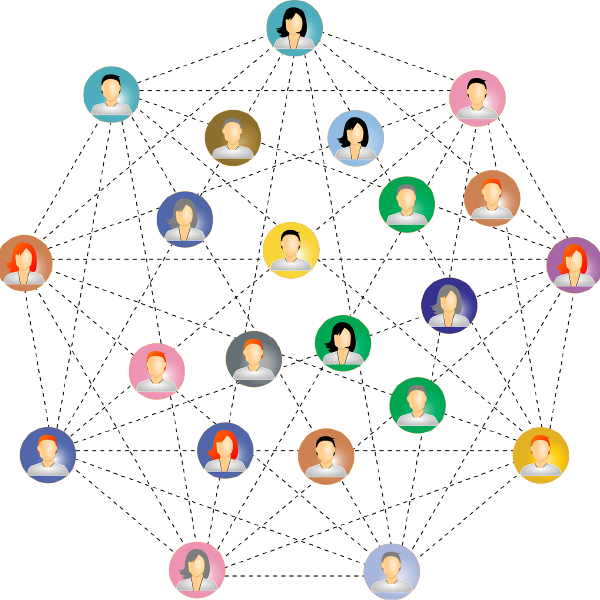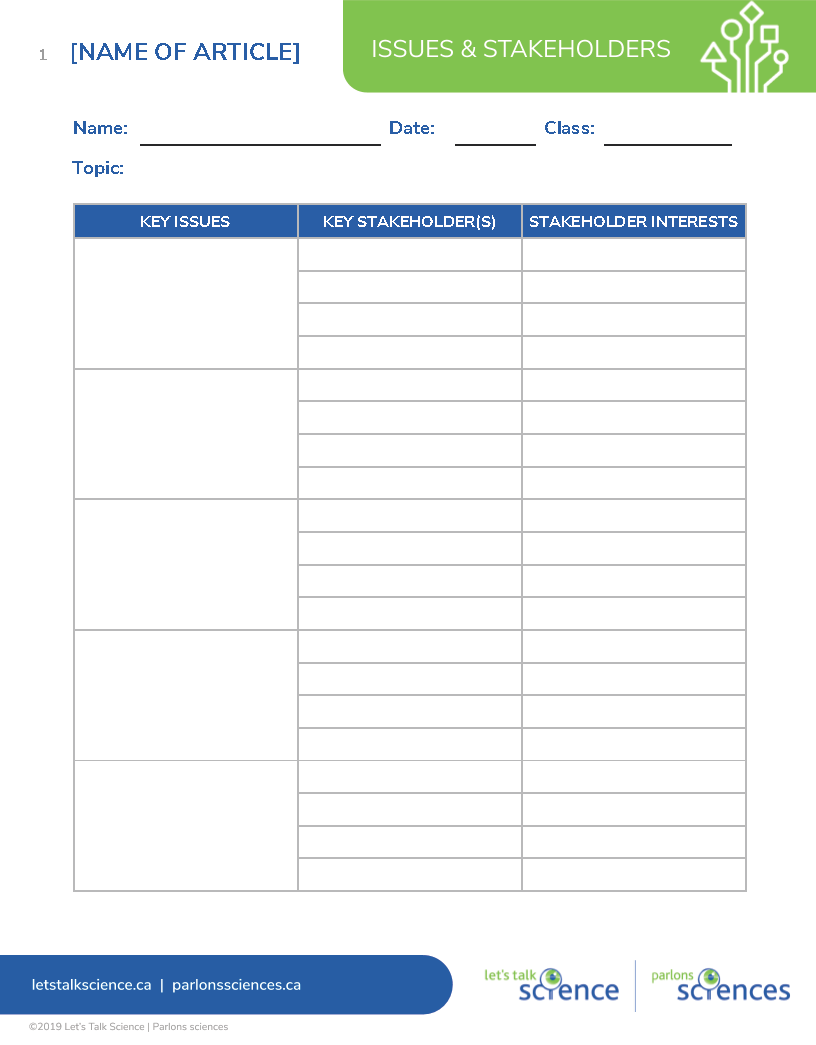Issues & Stakeholders

People connected together (Gordon Johnson, Pixabay)

People connected together (Gordon Johnson, Pixabay)
How does this align with my curriculum?
PE
9
Science Grade 9 (revised 2018)
Decisions and Perspectives
PE
10
Science 421A (2019)
Decisions and Perspectives
PE
12
Chemistry 621A (draft 2021)
Decisions and Perspectives DP1
PE
11
Chemistry 521A (draft 2021)
Decisions and Perspectives DP1
This strategy helps students develop critical thinking skills by identifying issues and stakeholders
Why use it?
- To enhance critical thinking skills
- To identify and consider different perspectives on a topic
- To increase awareness of the connections between science/technology and society
Tips for success
- For the first time using this strategy, you can have the class complete the chart together using an interactive white board.
- Practice identifying stakeholders using a situation familiar to students (e.g., getting a new pet, etc.).
- Help students to understand that stakeholders are not always mentioned but can be inferred (e.g., live in an affected area; have family or friends who may be affected, etc.).
How do I use it?
- Students will read a series of articles and/or watch a series of videos about a controversial topic (e.g., GMO foods, nuclear power, stem cells, etc.). The articles or videos must identify a variety of issues with the topic and include the perspectives of a variety of stakeholders
- As a class, brainstorm three to four key issues associated with the topic (e.g., for nuclear power the issues could be accidents, waste storage, cost, etc.). Have students write these issues in the Key Issues column of the reproducible (see image at right).
- In small groups, have students identify the people/groups whom they think would care about the issue (Key Stakeholders). These are typically individuals, groups of people or organizations who have something to lose or gain related to the issue. The stakeholders should be listed on the lines provided in the column marked Key Stakeholders. The same stakeholder can be listed for more than one issue.
- Next, have the same small groups identify why each of the stakeholders would care about the issue and record this beside the stakeholder’s name in the column marked Stakeholder Interests.
- Bring the class back together to discuss the results and add to each other’s charts.
Variations
- A single article/video could also be used as long as it includes a variety of issues and stakeholder perspectives.
- The issues could be distributed to small groups of students so that they only look at one of the issues, rather than all the issues.
Extensions
- To demonstrate understanding, students could write a short opinion piece about one of the issues, taking the perspective of one of the stakeholders.
- Students can share their own personal opinions about each of the issues, including which of the stakeholders (if any) they identify with.
- Hold a mock town hall meeting in which students role-play the various stakeholders.
Using this Strategy
- Issues & Stakeholders Reproducible Template [Google doc] [PDF]
-
Antimatter and Why It Matters to Me - Issues & Stakeholders Reproducible [Google doc] [PDF]
- Are Wind Farms a Threat to Wildlife? - Issues & Stakeholders Reproducible [Google doc] [PDF]
- Autonomous Trucks Case Study - Issues & Stakeholders Reproducible [Google doc] [PDF]
- Cleaning Up Nuclear Waste After Decommissioning: Issues & Stakeholders Reproducible [Google doc] [PDF]
- CSI Lac-Megantic: How are Victims Identified after a Disaster?: Issues & Stakeholders Reproducible [Google doc] [PDF]
-
Does living near high-voltage power lines cause cancer? - Issues & Stakeholders-Reproducible [Google doc] [PDF]
- Fresh Salmon vs. Wild Salmon: Issues & Stakeholders Reproducible [Google doc] [PDF]
- Genome Editing: Issues & Stakeholders Reproducible [Google doc] [PDF]
- Green Chemistry 101: Issues & Stakeholders Reproducible [Google doc] [PDF]
- Green Walls: Issues & Stakeholders Reproducible [Google doc] [PDF]
- How are the World's Bee Populations Doing?: Issues & Stakeholders Reproducible [Google doc] [PDF]
- Reaching the Arctic: Issues & Stakeholders Reproducible [Google doc] [PDF]
- What Are Carbon Offsets?: Issues & Stakeholders Reproducible [Google doc] [PDF]
- What are the Pros and Cons of Nuclear Energy?: Issues & Stakeholders Reproducible [Google doc] [PDF]
- What if You Could Choose Your Baby?: Issues & Stakeholders Reproducible [Google doc] [PDF]
- What is a Tornado?: Issues & Stakeholders Reproducible [Google doc] [PDF]
- What is Cloud Seeding?: Issues & Stakeholders Reproducible [Google doc] [PDF]
- What is Fracking?: Issues & Stakeholders Reproducible [Google doc] [PDF]
- Why is Henrietta Lacks Important?: Issues & Stakeholders Reproducible [Google doc] [PDF]
-
Why is it so hard to transplant a human head? - Issues & Stakeholders-Reproducible [Google doc] [PDF]
- Cleaning Up Nuclear Waste After Decommissioning: Issues & Stakeholders Student Sample [Google doc] [PDF]
Create Your Own
- Issues & Stakeholders Reproducible Template [Google doc] [PDF]
Ready to Use
-
Antimatter and Why It Matters to Me - Issues & Stakeholders Reproducible [Google doc] [PDF]
- Are Wind Farms a Threat to Wildlife? - Issues & Stakeholders Reproducible [Google doc] [PDF]
- Autonomous Trucks Case Study - Issues & Stakeholders Reproducible [Google doc] [PDF]
- Cleaning Up Nuclear Waste After Decommissioning: Issues & Stakeholders Reproducible [Google doc] [PDF]
- CSI Lac-Megantic: How are Victims Identified after a Disaster?: Issues & Stakeholders Reproducible [Google doc] [PDF]
-
Does living near high-voltage power lines cause cancer? - Issues & Stakeholders-Reproducible [Google doc] [PDF]
- Fresh Salmon vs. Wild Salmon: Issues & Stakeholders Reproducible [Google doc] [PDF]
- Genome Editing: Issues & Stakeholders Reproducible [Google doc] [PDF]
- Green Chemistry 101: Issues & Stakeholders Reproducible [Google doc] [PDF]
- Green Walls: Issues & Stakeholders Reproducible [Google doc] [PDF]
- How are the World's Bee Populations Doing?: Issues & Stakeholders Reproducible [Google doc] [PDF]
- Reaching the Arctic: Issues & Stakeholders Reproducible [Google doc] [PDF]
- What Are Carbon Offsets?: Issues & Stakeholders Reproducible [Google doc] [PDF]
- What are the Pros and Cons of Nuclear Energy?: Issues & Stakeholders Reproducible [Google doc] [PDF]
- What if You Could Choose Your Baby?: Issues & Stakeholders Reproducible [Google doc] [PDF]
- What is a Tornado?: Issues & Stakeholders Reproducible [Google doc] [PDF]
- What is Cloud Seeding?: Issues & Stakeholders Reproducible [Google doc] [PDF]
- What is Fracking?: Issues & Stakeholders Reproducible [Google doc] [PDF]
- Why is Henrietta Lacks Important?: Issues & Stakeholders Reproducible [Google doc] [PDF]
-
Why is it so hard to transplant a human head? - Issues & Stakeholders-Reproducible [Google doc] [PDF]
Issues & Stakeholders Student Samples
- Cleaning Up Nuclear Waste After Decommissioning: Issues & Stakeholders Student Sample [Google doc] [PDF]
References
Misfeldt, C., Browne, C., Smith, D., Sclater, K., Hughes, L., & Windsor, V. (2002). Brazilian rain forest. Critical Thinking Consortium.
Department of Writing, Rhetoric, and Digital Studies. (2012, November 28). Understanding stakeholder perspectives. University of Kentucky.
